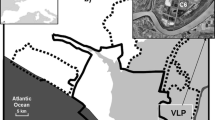Summary
Different initial mixtures of phyto-and zooplankton from different lakes were grown under identical chemical and physical conditions in medium size (8-and 12–1) laboratory microcosm cultures until convergence of phytoplankton species composition was attained. Five such experiments with four (four experiments) or three (one experiment) microcosm cultures were run. Three experiments were performed with weak stirring which permitted sedimentary elimination of the diatoms. Two experiments were conducted with stronger stirring to prevent sedimentation. In the three “sedimentation intensive” experiments, the final phytoplankton community was composed of the filamentous chlorophyte Mougeotia thylespora together with a smaller biomass of nanoplanktic algae. In the two “sedimentation free” experiments the final phytoplankton community consisted of pennate diatoms. Both dissolved nutrient concentrations and the chemical composition of biomass suggested strong nutrient limitation of algal growth rates in the final phase of the experiments. The zooplankton communities at the end of the experiments were composed of species that were apparently unable to ingest the large, dominant algae and that presumably fed on the nanoplanktic “undergrowth” and the bacteria. There was a distinct sequence of events in all experiments: first, the large zooplankton species (Daphnia and Copepoda) were replaced by smaller ones (Chydorus, Bosmina, rotifers); second, all cultures within one experiment developed the same nutritional status (limitation by the same nutrient); and third, the taxonomic composition of phytoplankton of the different cultures within one experiment converged. The last took 7–9 weeks, with is about 2–3 times as long as the time needed in a phytoplankton competition experiment to reach the final outcome.
Similar content being viewed by others
References
Bray JR Curtis JT (1957) An ordination of the upland forest communities of Southern Wisconsin. Ecol Monogr 27: 325–349
Brooks JL, Dodson SI (1965) Predation, body size and composition of plankton. Science 150: 28–35
Burns C (1969) The relationship between body size of filter-feeding Cladocera and the maximum size of particles ingested. Limnol Oceanogr 13: 675–678
Geller W, Müller H (1981) The filtration apparatus of Cladocera: filter mesh-sizes and their implications on food-selectivity. Oecologia 49: 316–321
Gliwicz ZM (1977) Food-size selection and seasonal succession of filter fecding zooplankton in a eutrophic lake. Ekol Polska 25: 179–225
Gliwicz ZM (in press) Daphnia growth at different concentrations of filaments. Arch Hydrobiol
Goldman JC, McCarthy JJ, Peavey DG (1979) Growth rate influence on the chemical composition of phytoplankton in oceanic waters. Nature 279: 210–215
Harris GP (1986) Phytoplankton ecology. Chapman and Hall, London
Hawkins P, Lampert W (1989) The effect of Daphnia body size on filtering rate inhibition in the presence of a filamentous cyanobacterium. Limnol Oceanogr 34: 1084–1089
Knisely K, Geller W (1986) Selective feeding of four zooplankton species on natural lake phytoplankton. Oecologia 69: 86–94
Kohl JG, Nicklisch A (1988) Ökophysiologie der Algen. Akademie Verlag, Berlin
Lampert W, Schober U (1978) Das regelmäßige Auftreten von Frühjahrsblüte und “Klarwasserstadium” im Bodensee als Folge klimatischer bedingungen und Wechselwirkungen zwischen Phyto-und Zooplankton. Arch Hydrobiol 82: 364–386
Rocha O, Duncan A (1985) The relationship between cell carbon and cell volume in freshwater algal species used in zooplankton studies. J Plankton Res 7: 279–294
Roughgarden J, Gaines SD, Pacala SW (1987) Supply side ecology: The role of physical transport processes. In Gee JHR, Giller PS (eds) Organisation of communities past and present. Blackwell, Oxford, pp 491–518
Smith RE, Kalff J (1983) Competition for phosphorus among cooccurring freshwater phytoplankton. Limnol Oceanogr 28: 448–464
Sommer U (1983) Nutrient competition between phytoplankton species in multispecies chemostat experiments. Arch Hydrobiol 96: 399–416
Sommer U (1985) Comparison between steady state and non-steady state competition: Experiments with natural phytoplankton. Limnol Oceanogr 30: 335–346
Sommer U (1986) Phytoplankton competition along a gradient of dilution rates. Oecologia 68: 503–506
Sommer U (1988a) Phytoplankton succession in microcosm experiments under simultaneous grazing pressure and resource limitation. Limnol Oceanogr 33: 1037–1054
Sommer U (1988b) Does nutrient competition among phytoplankton occur in situ? Verh Internal Verein Limnol 23: 707–712
Sommer U (1989a) The role of competition for resources in phytoplankton succession. In Sommer U (ed) Plankton ecology: Succession in plankton communities. Springer, Berlin, pp 57–106
Sommer U (1989b) Nutrient status and nutrient competition of phytoplankton in a shallow, hypertrophic lake. Limnol Oceanogr 34: 1162–1173
Sommer U (in press) The application of the Droop-model of nutrient limitation to natural phytoplankton. Vert Internal Verein Limnol 24:
Sommer U, Gliwicz ZM, Lampert W, Duncan A (1986) The PEG-model of seasonal succession of planktonic events in fresh waters. Arch Hydrobiol 106: 433–471
Sterner RW (1986) Herbivores direct and indirect effects on algal populations. Science 231: 605–607
Sterner RW (1989) The role of grazers in phytoplankton succession. In Sommer U (ed) Plankton Ecology: Succession in plankton communities, Springer, Berlin, pp 107–170
Strickland JDH, Parsons DR (1972) A practical handbook of seawater analysis. 2nd edn. Bull Fish Res Board Can 167
Tessenow U (1966) Untersuchungen über den Kieselsäuregehalt der Binnengewässer. Arch Hydrobiol Suppl 32: 1–136
Tilman D (1982) Resource competition and community structure. Princeton Univ Press, Princeton
Tilman D, Sterner RW (1984) Invasions of equilibria: test of resource competition using two species of algae. Oecologia 61: 197–200
Tilman D, Kilham SS, Kilham P (1982) Phytoplankton community ecology: The role of limiting nutrients. Ann Rev Ecol Syst 13: 349–372
Tilman D, Kiesling R, Sterner RW, Kilham SS, Johnson FA (1986) Green, bluegreen and diatom algae: Taxonomic differences in competitive ability for phosphorus, silicon and nitrogen. Arch Hydrobiol 106: 473–485
Webster KE, Peters RH (1978) Some size-dependent inhibitions of larger cladoceran filterers in filamentous suspensions. Limnol Oceanogr 23: 1238–1245
Author information
Authors and Affiliations
Rights and permissions
About this article
Cite this article
Sommer, U. Convergent succession of phytoplankton in microcosms with different inoculum species composition. Oecologia 87, 171–179 (1991). https://doi.org/10.1007/BF00325254
Received:
Accepted:
Issue Date:
DOI: https://doi.org/10.1007/BF00325254




